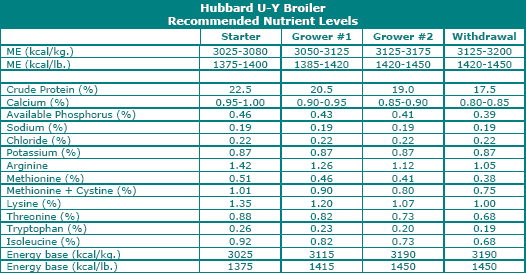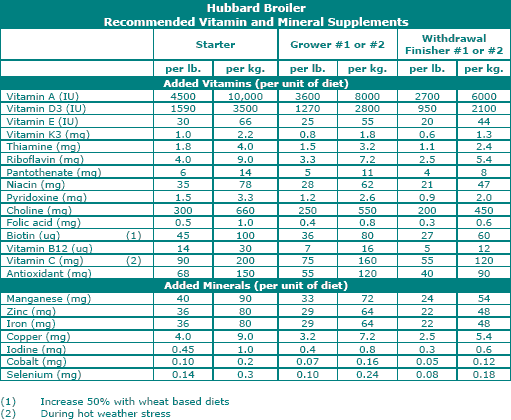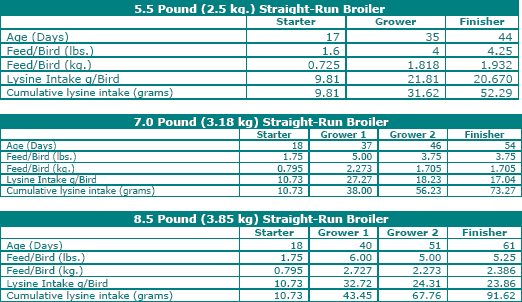



Feeding the Yield-Type Broiler for Optimum Performance
By Dr. Michael Hellwig and Dr. James A. Ranson, Hubbard Breeders - The live weight of the yield-type broiler is increasing each year. This is driven by the demand for deboned meat and the reduction of per-unit meat processing cost at heavier weights.It is quite common to process straight-run broilers at 5V2-7.0 Ibs. (2.5-3.2 kg.) in the U.S. while some companies are exceeding 8.0 Ibs. (3.6 kg.) live weight. Producing these heavy broilers requires adequate nutrition to promote early skeletal development, optimize live bird performance and allow the bird to express its meat yield potential. The dietary density needed for optimum performance has increased as the amount of feed per unit gain (FCR) has decreased.
This requires a balance of amino acids, minerals, vitamins and energy. Proper management programs such as temperature control, ventilation and lighting are also very important, as well as bird health. This technical bulletin will focus primarily on Hubbard's recommended nutrition and feeding for the yield-type broiler.
Recommended Nutrient Levels
Hubbard's recommended nutrient levels are summarized in the following tables:


The minimum protein levels listed are those that have been successfully used with synthetic lysine, methionine and threonine to obtain optimum performance under a wide range of field conditions.
The levels of amino acids shown in all the diets are designed to promote good growth, FCR and optimum yield. If the dietary energy levels are much different from those shown, then the amino acid levels should be adjusted accordingly to maintain similar amino add to energy ratios. If the amino acid density is lowered, particularly lysine, by as much as four or five percent (0.05-0.06% total lysine), the white meat yield may drop by at least one percent with an increase in FCR.
The broiler is quite adaptable to a wide range of energy levels and within reason the bird is able to adjust feed intake accordingly. The adjustment is not perfect and the broiler tends to consume less energy on the lower energy diets. When economic conditions dictate the use of a lower energy program and/or lower density diets, it will be necessary to increase the hours of daily light in the lighting program. This will allow the broiler to partially compensate by giving it more feed consumption time.
It is important to build a good skeletal "foundation" early to support the heavy muscle development in the yield-type broilers. The recommended levels of calcium and phosphorus are shown above. Lower levels, especially in the starter and grower diets, have been associated with higher incidences of leg problems which often occur after 3-4 weeks of age. The available phosphorus levels listed are adequate with the use of phytase, when phytase values are equivalent to 0.07-0.10 percent available phosphorus in the diet.
Calcium levels in the starter and grower diets should NOT be adjusted down for phytase when leg problems have been an issue. The use of HyD (25-Hydroxyvitamin 03) in the starter diet has also been shown to be helpful in promoting bone development. The suggested inclusion level is 62.5 mg/ton (68.75 mg/metric ton) of HyD in addition to the normal level of added vitamin D (1590 lU/lb. or 3500 lU/kg).
Feeding Schedules
The recommended feeding schedules, estimated feed consumption and accumulated lysine at specific ages for 5.5, 7.0 and 8.5 pound (2.5, 3.18, 3.85 kg.) straight-run broilers are summarized in the following tables. These represent the typical high-yield broiler weight range being processed today.

It is a common practice to use a three-feed program for broilers grown up to ±6.0 Ibs. (2.72 kg.) and a four-feed program for heavier broilers. The age at which one feed type is changed to another, i.e. Starter to Grower, etc, will vary according to the final desired body weight.
The suggested feeding programs in the above examples allows the broiler to proportionally consume the recom-mended nutrients, such as lysine, by specific ages as the birds are grown to heavier weights. However, the early nutrient consumption before 35-40 days of age is especially important to achieve optimum final live bird performance and meat yield.
September 2006









